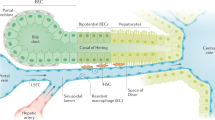Abstract
Hepatic nonparenchymal cells represent approximately 30–35% of the cells in the liver. The majority of these cells, which include Kupffer cells, endothelial cells, fat storing cells and pit cells reside within the hepatic sinusoids. Because of their small size relative to hepatocytes and the small volume that they occupy in the liver, nonparenchymal liver cells have largely been ignored in studies aimed at elucidating cellular mechanisms of heptotoxicity. However, following exposure to hepatotoxic chemicals, nonparenchymal cells become “activated”. They release large quantities of highly reactive mediators such as superoxide anion and hydrogen peroxide, eicosinoids and proteolytic enzymes which have the capacity to damage hepatic tissue. Thus these cells may contribute to pathophysiologic processes leading to toxicity.
Access this chapter
Tax calculation will be finalised at checkout
Purchases are for personal use only
Preview
Unable to display preview. Download preview PDF.
Similar content being viewed by others
References
Adams, D.O. and Hamilton, T.A. (1984). The cell biology of macrophage activation. Annu. Rev. Immunol. 2, 283–318.
Authur, M.J.P., Bentley, I.S., Tanner, A.R., Kowalski Saunders, P., Millward-Sadler, G.H., and Wright, R. (1985). Oxygen derived free radicals promote hepatic injury in the rat. Gastroenterology 89, 1114–1122.
Boyden, S.V. (1962). The chemotactic effect of mixtures of antibody and antigen on polymorphonuclear leukocytes. J. Exp. Med. 115, 453–466.
Cotran, R.S. (1987). New roles for the endothelium in inflammation and immunity. Amer. J. Pathol. 129, 407–413.
Diesselholf-Den Dulk, M.M., Crofton, R.W., and van Furth, R. (1979). Origin and kinetics of Kupffer cells during an acute inflammatory response. Immunol. 377, 7–14.
Dinarello, C.A. (1989). Interleukin-1 and its related cytokines. In Macrophage-Derived Cell Regualtory Factors. Cytokines ( C. Sorg, ed.), pp. 105–154, Karger, Basel.
Helle, M, Boeije, L., and Aarden, L.A. (1988). Functional discrimination between interleukin 6 and interleukin 1. Eur. J. Immunol. 18, 1535–1540.
Husztik, E., Lazar, G., Parducz, A. (1980). Electron microscopic study of Kupffer cell phagocytosis blockade induced by gadolinium chloride. Br. J. Exp. Pathol. 61, 624–630.
Knook, D.L., Blansjaar, N., Sleyster, ECh. (1976). Isolation and characterization of Kupffer and endothelial cells from the rat liver. Exp. Cell Res. 99, 444–449.
Kurt-Jones, E.A., Beller, D.I., Mizel, S.B., and Unanue, E.R. (1985). Identification of a membrane-associated interleukin 1 in macrophages. Proc. Natl. Acad. Sci. USA 82, 1204–1208.
Laskin, D.L. and Pilaro, A.M. (1986). Potential role of activated macrophages in acetaminophen hepatotoxicity. I. Isolation and characterization of activated macrophages from rat liver. Toxicol. Appl. Pharmacol. 86, 204–215.
Laskin, D.L., Laskin, J.D., Weinstein, I.B., and Carchman, R.A. (1981). Induction of chemotaxis in mouse peritoneal macrophages by phorbol ester tumor promoters. Cancer Res. 41, 1923–1928.
Laskin, D.L., Pilaro, A.M. and Ji, S. (1986). Potential role of activated macrophages in acetaminophen hepatotoxicity. II. Mechanism of macrophage accumulation and activation. Toxicol. Appl. Pharmacol. 86, 216–226.
Laskin, D.L., Robertson, F.M., Pilaro, A.M. and Laskin, J.D. (1988a). Activation of liver macrohages following phenobarbital treatment of rats. Hepatology 8, 1051–1055.
Laskin, D.L., Sirak, A.A., Pilaro, A.M., and Laskin, J.D. (1988b). Functional and biochemical properties of rat Kupffer cells and peritoneal macrophages. J. Leuk. Biol. 44, 71–78.
Lautenschlager, I., Vaananen, H., and Kulonea, E. (1982). Quantitative study on the Kupffer cells in the liver of ethanol-and carbon tetrachloride-treated rats. Acta. Pathol. Microbiol. Immunol. Scand. 90, 347–351.
Matsubara T. and Ziff, M. (1986). Increased superoxide anion release from human endothelial cells in response to cytokines. J. Immunol. 137, 3295–3298.
Ooi, B.S., MacCarthy, E.P., Hsu, A., Ooi, Y.M. (1983). Human mononuclear cell modulation of endothelial cell proliferation. J. Lab. Clin. Med. 102, 428–433.
Pilaro, A.M. and Laskin, D.L. (1986). Accumulation of activated mononuclear phagocytes in the liver following lipopolysaccharide treatment of rats. J. Leuk. Biol. 40, 29–41.
Salvemini, D., Korbut, R., Anggard, E., and Vane, J.R. (1989). Lipopolysaccharide increases release of nitric oxide-like factor from endothelial cells. Eur. J. Pharmacol. 171, 135–136.
Sironi, M. Breviario, F., Proserpio, P., Biondi, A., Vecchi, A., Van Damme, J., Dejana, E., and Mantovani, A. (1989). IL-1 stimulates IL-6 production in endothelial cells. J. Immunol. 142, 549–553.
Souhami, R.L. and Bradfield, J.W. The recovery of hepatic phagocytosis after blockade of Kupffer cells. J. Reticuloendothel. Soc. 16, 75–86.
Tanner, A., Kehani, A., Reiner, R., Holdstock, G., and Wright, R. (1981). Proteolytic enzymes released by liver macrohages may promote hepatic injury in a rat model of hepatic damage. Gastroenterology 80, 647–654.
Author information
Authors and Affiliations
Editor information
Editors and Affiliations
Rights and permissions
Copyright information
© 1991 Plenum Press, New York
About this chapter
Cite this chapter
Laskin, D.L. (1991). Parenchymal and Nonparenchymal Cell Interactions in Hepatotoxicity. In: Witmer, C.M., Snyder, R.R., Jollow, D.J., Kalf, G.F., Kocsis, J.J., Sipes, I.G. (eds) Biological Reactive Intermediates IV. Advances in Experimental Medicine and Biology, vol 283. Springer, Boston, MA. https://doi.org/10.1007/978-1-4684-5877-0_66
Download citation
DOI: https://doi.org/10.1007/978-1-4684-5877-0_66
Publisher Name: Springer, Boston, MA
Print ISBN: 978-1-4684-5879-4
Online ISBN: 978-1-4684-5877-0
eBook Packages: Springer Book Archive




